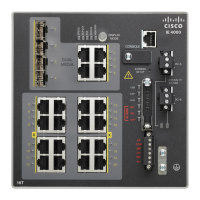362
Configuring Optional Spanning-Tree Features
How to Configure the Optional Spanning-Tree Features
Default Optional Spanning-Tree Settings
How to Configure the Optional Spanning-Tree Features
Enabling Optional SPT Features
Before You Begin
Make sure that there are no loops in the network between the trunk port and the workstation or server before you
enable PortFast on a trunk port.
Use PortFast only when connecting a single end station to an access or trunk port. Enabling this feature on an
interface connected to a switch or hub could prevent spanning tree from detecting and disabling loops in your
network, which could cause broadcast storms and address-learning problems.
An interface with the PortFast feature enabled is moved directly to the spanning-tree forwarding state without
waiting for the standard forward-time delay.
You cannot enable both loop guard and root guard at the same time.
When you enable UplinkFast, it affects all VLANs on the switch. You cannot configure UplinkFast on an individual
VLAN.
If you enable the voice VLAN feature, the PortFast feature is automatically enabled. When you disable voice VLAN,
the PortFast feature is not automatically disabled.
Table 45 Default Optional Spanning-Tree Settings
Feature Default Setting
PortFast, BPDU filtering, BPDU guard Globally disabled (unless they are individually configured per
interface).
UplinkFast Globally disabled.
BackboneFast Globally disabled.
EtherChannel guard Globally enabled.
Root guard Disabled on all interfaces.
Loop guard Disabled on all interfaces.
Command Purpose
1. show spanning-tree active
or
show spanning-tree mst
Verifies which interfaces are alternate or root ports.
2. configure terminal Enters global configuration mode.
3. spanning-tree loopguard default Enables loop guard.
By default, loop guard is disabled.
4. spanning-tree portfast bpduguard default Enables BPDU guard.
By default, BPDU guard is disabled.

